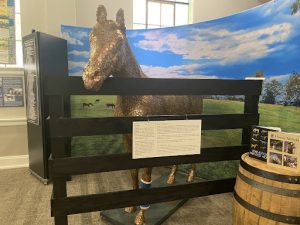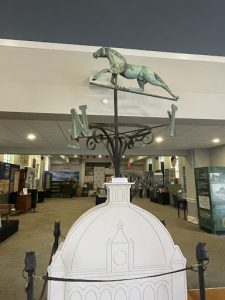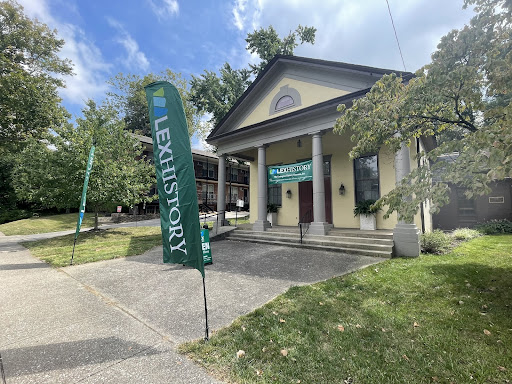On August 26, LexHistory and the Bluegrass Trust for Historic Preservation held a grand opening for the Lexington History Museum, the first of its kind after an absence of over a decade. The new museum is located at 210 N. Broadway inside the Thomas Hunt Morgan House, the historic home of Kentucky’s first Nobel Prize winner. The Lexington History Museum originally opened in 1998 in the old Fayette County Courthouse. The museum was forced to vacate that location in 2012 due to the discovery of hazardous lead paint dust and mold. In the ten years following the eviction, the Lexington History Museum was forced to operate without a central location, relying on temporary exhibits in public locations and focusing on online resources. Signage in the new museum admits that in this time, “LexHistory suffered a reduction in community engagement and financial support due to diminished public presence and awareness.” The new museum is part of a multi-year  agreement with the city of Lexington, which will provide LexHistory with $270,000 in yearly funding as long as specific benchmarks are met, including a physical location.
agreement with the city of Lexington, which will provide LexHistory with $270,000 in yearly funding as long as specific benchmarks are met, including a physical location.
The main gallery of the museum tells the story of Lexington from prehistoric times to the modern day, with a particular focus on the economic development of the city and the main industries that drove it. This starts with a smaller exhibit on Kentucky before the arrival of Europeans and the first Lexington settlement along the Town Branch, highlighted by a collection of artifacts from the William S. Webb Museum of Anthropology. The museum moves into Lexington’s first profitable industry, hemp, and underscores both how it enriched Lexington’s earliest elite families, notably the Hunts and Clays, and how labor-intensive every step of planting and processing was, work that was almost entirely performed by enslaved individuals. The growth of the hemp industry led to the image of Lexington as the “Athens of the West,”. The section of the museum covering this growth contains artifacts that represent the increasing luxuries enjoyed by Lexington’s elite, from sugar chests to Blanchard silver cups. The museum next covers Lexington’s status as the ‘Horse Capital of the World,’ exploring famous stories such as the founding of Red Mile and Keeneland and the success of the Madden family at Hamburg Place. The exhibit also includes lesser-known stories such as the contributions of Black jockeys and trainers to early Kentucky Derby winners, the history of black four-rail fences, and the HorseMania events of the 21st century. Another of Lexington’s world-famous industries is Bourbon, and the museum tells the history of some of Lexington’s most famous distilleries of the past and present, from James E. Pepper to the Town Branch Distillery. These industries were bolstered in the late 19th and 20th centuries by the success of the hotel industry in Lexington. The museum focuses on the Phoenix Hotel that operated in downtown Lexington in some capacity from 1797 to 1981, highlighting its famous guests and its importance to the Civil Rights movement in Kentucky with the 1961 NBA boycott. The later portions of the museum dedicate significant attention to the importance of IBM in 20th-century Lexington, displaying several IBM products and contrasting how its arrival drove up local wages but led to divestment in downtown Lexington. Other aspects of the museum include a whole room dedicated to the Hunt Morgan Family that once lived on the property and a wind vane that once stood atop the old Fayette County Courthouse that is displayed at the entrance.
Black jockeys and trainers to early Kentucky Derby winners, the history of black four-rail fences, and the HorseMania events of the 21st century. Another of Lexington’s world-famous industries is Bourbon, and the museum tells the history of some of Lexington’s most famous distilleries of the past and present, from James E. Pepper to the Town Branch Distillery. These industries were bolstered in the late 19th and 20th centuries by the success of the hotel industry in Lexington. The museum focuses on the Phoenix Hotel that operated in downtown Lexington in some capacity from 1797 to 1981, highlighting its famous guests and its importance to the Civil Rights movement in Kentucky with the 1961 NBA boycott. The later portions of the museum dedicate significant attention to the importance of IBM in 20th-century Lexington, displaying several IBM products and contrasting how its arrival drove up local wages but led to divestment in downtown Lexington. Other aspects of the museum include a whole room dedicated to the Hunt Morgan Family that once lived on the property and a wind vane that once stood atop the old Fayette County Courthouse that is displayed at the entrance.
The Lexington History Museum is open from Noon to 4 PM on Thursday and Friday and 10 AM to 4 PM on Saturdays.



